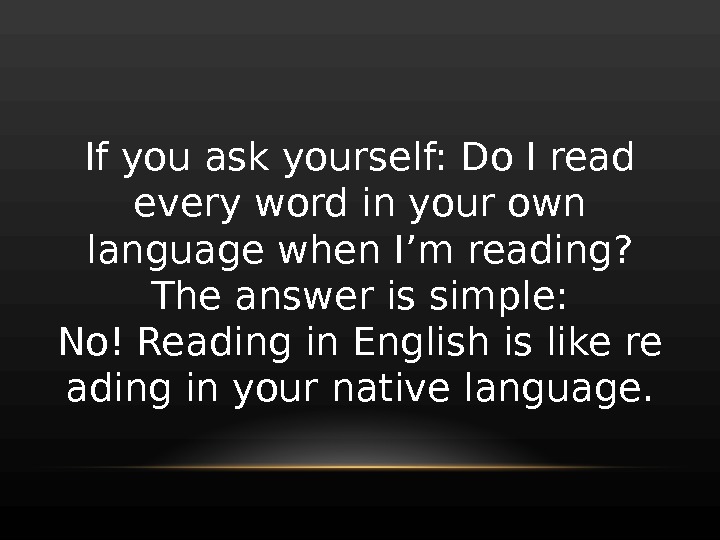Подготовила: Агафонова Александра. IMPROVEREADINGSK ILLS If you











reading_skills_-_agafonova_a.v..ppt
- Размер: 402.5 Кб
- Количество слайдов: 10
Описание презентации Подготовила: Агафонова Александра. IMPROVEREADINGSK ILLS If you по слайдам
 Подготовила: Агафонова Александра. IMPROVEREADINGSK ILLS
Подготовила: Агафонова Александра. IMPROVEREADINGSK ILLS
 If you ask yourself: Do I read every word in your own language when I’m reading? The answer is simple: No!Readingin. Englishislikere ading inyournativelanguage.
If you ask yourself: Do I read every word in your own language when I’m reading? The answer is simple: No!Readingin. Englishislikere ading inyournativelanguage.
 Thismeansthatitisnotalways necessary toreadandunderstandeachande verywordin English. Remember thatreadingskillsinyournativelan guage and. Englisharebasically thesame.
Thismeansthatitisnotalways necessary toreadandunderstandeachande verywordin English. Remember thatreadingskillsinyournativelan guage and. Englisharebasically thesame.
 I decide to makeaquickoverviewofthefourtypes ofreadingskillsusedin everylanguage: Skimming -usedtounderstandthe»gis t»ormainidea Scanning -usedtofindaparticularpiec eofinformation Extensivereading -usedforpleasurea ndgeneralunderstanding Intensivereading -accuratereadingfo rdetailedunderstanding
I decide to makeaquickoverviewofthefourtypes ofreadingskillsusedin everylanguage: Skimming -usedtounderstandthe»gis t»ormainidea Scanning -usedtofindaparticularpiec eofinformation Extensivereading -usedforpleasurea ndgeneralunderstanding Intensivereading -accuratereadingfo rdetailedunderstanding
 As so Ann is telling you about “Scanning and skimming”, I tell you about Extensivereading and Intensivereading
As so Ann is telling you about “Scanning and skimming”, I tell you about Extensivereading and Intensivereading
 EXTENSIVEREADING Extensivereadingisusedtoobtainageneral understandingofa subjectand includes reading longer textsforpleasure, aswellas businessbooks. Useextensivereadingskillstoimproveyour generalknowledgeofbusinessprocedures. Donotworryifyou don’tunderstandeachword.
EXTENSIVEREADING Extensivereadingisusedtoobtainageneral understandingofa subjectand includes reading longer textsforpleasure, aswellas businessbooks. Useextensivereadingskillstoimproveyour generalknowledgeofbusinessprocedures. Donotworryifyou don’tunderstandeachword.
 SOME PRINCIPLES 1. Don’t look up words in the dictionary. 2. Skip over parts you don’t understand. 3. If you aren’t enjoying one book, toss it aside and get another. Examples of Extensivereading Thelatestmarketingstrategybook Anovelyoureadbeforegoingtobed Magazinearticlesthatinterestyou
SOME PRINCIPLES 1. Don’t look up words in the dictionary. 2. Skip over parts you don’t understand. 3. If you aren’t enjoying one book, toss it aside and get another. Examples of Extensivereading Thelatestmarketingstrategybook Anovelyoureadbeforegoingtobed Magazinearticlesthatinterestyou
 INTENSIVEREADING Intensivereadingisusedonshortert extsinordertoextractspecific information. Itincludesverycloseac curatereadingfordetail. Use intensivereadingskillstograspthe detailsofaspecificsituation. In thiscase, itisimportantthatyouun derstandeachword, numberor fact.
INTENSIVEREADING Intensivereadingisusedonshortert extsinordertoextractspecific information. Itincludesverycloseac curatereadingfordetail. Use intensivereadingskillstograspthe detailsofaspecificsituation. In thiscase, itisimportantthatyouun derstandeachword, numberor fact.
 SOME PRINCIPLES • O – Overview (looking on the titles, pictures, the beginning, headings, and endings, and note illustrations) • P – Purpose (what you wish to get from the reading: ideas, facts, how long you need in it) • Q – Questions (make a questions) • R – Reading (The most familiar technique and the heart of intensive reading is to read carefully and thoughtfully. ) • S – Summarize (An important part of summarizing is organizing the ideas and supporting points. ) Examplesof Intensive. Reading Abookkeepingreport Aninsuranceclaim Acontract
SOME PRINCIPLES • O – Overview (looking on the titles, pictures, the beginning, headings, and endings, and note illustrations) • P – Purpose (what you wish to get from the reading: ideas, facts, how long you need in it) • Q – Questions (make a questions) • R – Reading (The most familiar technique and the heart of intensive reading is to read carefully and thoughtfully. ) • S – Summarize (An important part of summarizing is organizing the ideas and supporting points. ) Examplesof Intensive. Reading Abookkeepingreport Aninsuranceclaim Acontract
 Thanks for attention!
Thanks for attention!

